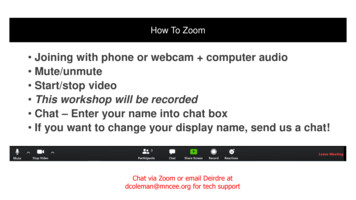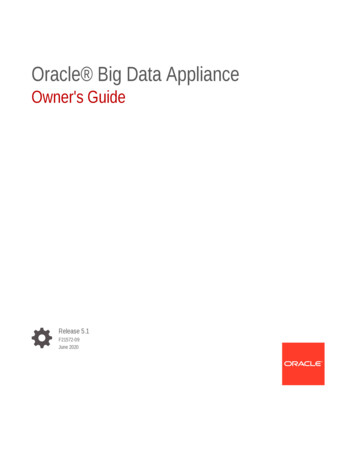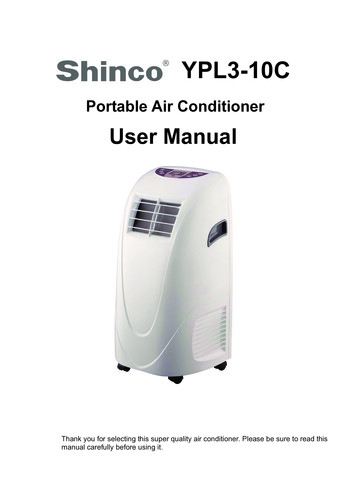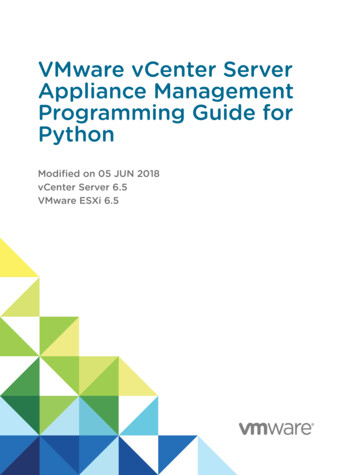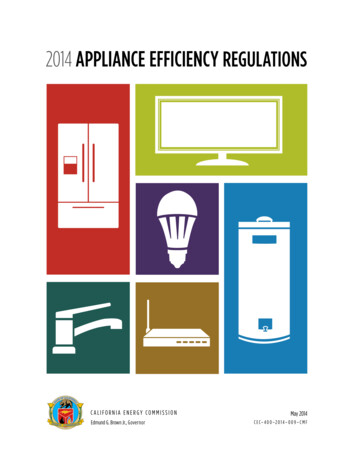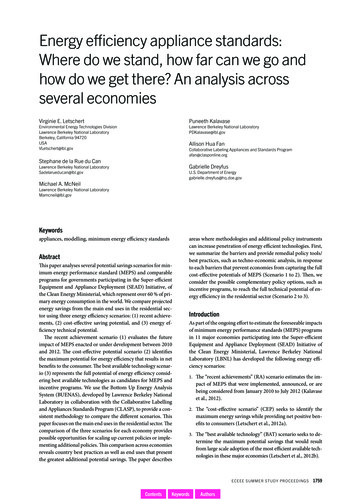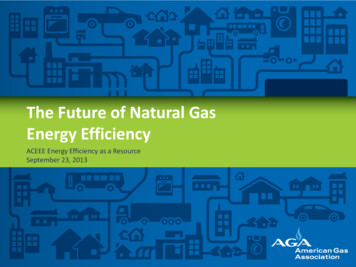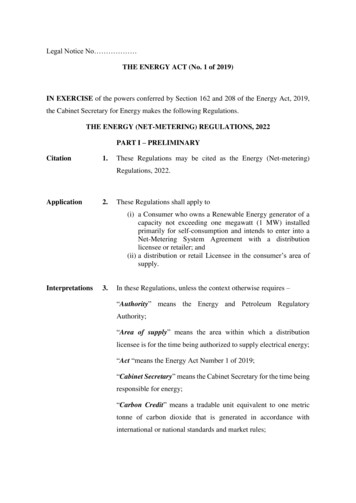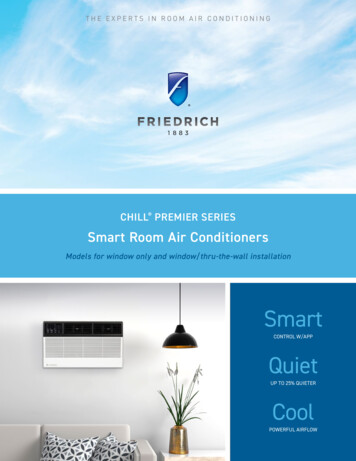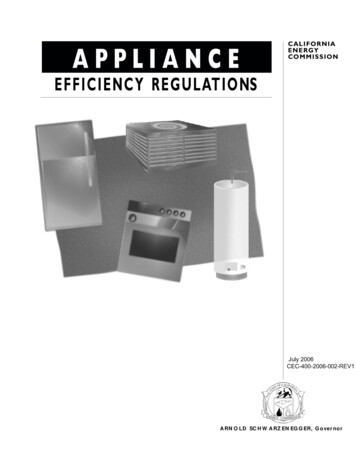
Transcription
APPLIANCECALI FORNIAE N E RGYCOMMISSIONEFFICIENCY REGULATIONSJuly 2006CEC-400-2006-002-REV1ARNOLD SCHWARZENEGGER, Governor
CALIFORNIAENERGYCOMMISSIONJackalyne PfannenstielChairmanJames D. BoydVice ChairCommissioners:Arthur H. RosenfeldJohn L. GeesmanJeffrey D. ByronValerie HallDeputy DirectorEfficiency, Renewables, andDemand Analysis DivisionG. William PenningtonOffice ManagerBuildings and Appliances OfficeB.B. BlevinsExecutive Director
ABSTRACTThese Appliance Efficiency Regulations, (California Code of Regulations, Title 20, Sections1601 through 1608) dated July 2006, were adopted by the California Energy Commission onMay 24, 2006, and approved by the California Office of Administrative Law on June 23, 2006.These Appliance Efficiency Regulations replace all previous versions of California ApplianceEfficiency Regulations.The Appliance Efficiency Regulations include standards for both federally-regulated appliancesand non-federally-regulated appliances. Twenty-one categories of appliances are included inthe scope of these regulations. The standards within these regulations apply to appliances thatare sold or offered for sale in California, except those sold wholesale in California for final retailsale outside the state and those designed and sold exclusively for use in recreational vehiclesor other mobile equipment.KEYWORDSAppliance Efficiency Regulations, appliance standards, refrigerators, air conditioners, spaceheaters, water heaters, pool heaters, plumbing fittings, plumbing fixtures, showerheads, sprayvalves, faucets, tub spout diverters, water closets, urinals, fluorescent lamp ballasts, lamps,emergency lighting, exit signs, traffic signal modules, traffic signal lamps, luminaires,torchieres, metal halide luminaires, under-cabinet luminaires, dishwashers, clothes washers,clothes dryers, cooking products, food service equipment, electric motors, low voltage dry-typedistribution transformers, external AC to DC and AC to AC power supplies, consumerelectronics, consumer audio and video equipment, televisions, compact audio products, digitalversatile disc players, digital versatile disc recorders, digital television adapters
TABLE OF CONTENTSSection TitlePageTITLE 20 APPLIANCE EFFICIENCY REGULATIONS1601Scope . 11602Definitions . 41602.1 Rules of Construction . 461603Testing: All Appliances . 471604Test Methods for Specific Appliances . 491605Energy Performance, Energy Design, Water Performance, andWater Design Standards: In General . 751605.1 Federal and State Standards for Federally-Regulated Appliances. 771605.2 State Standards for Federally-Regulated Appliances. 971605.3 State Standards for Non-Federally-Regulated Appliances . 1041606Filing by Manufacturers; Listing of Appliances in Database . 1251607Marking of Appliances . 1581608Compliance, Enforcement, and General Administrative Matters . 164(This Table of Contents is not part of the Regulations but is provided for the convenience of thereader.)
LIST OF TABLESTableTitlePageA-1Non-Commercial Refrigerator, Refrigerator-Freezer, and Freezer Test Methods.49A-2Commercial Refrigerator, Refrigerator-Freezer, and Freezer Test Methods.50B-1Room Air Conditioner, Room Air-Conditioning Heat Pump, PackagedTerminal Air Conditioner, and Packaged Terminal Heat Pump Test Methods .51C-1Central Air Conditioner Test Methods.52DSpot Air Conditioner, Ceiling Fan, Evaporative Cooler, Whole House Fan, andResidential Exhaust Fan Test Methods.53E-1Gas and Oil Space Heater Test Methods.54F-1Small Water Heater Test Methods .55GPool Heater Test Methods .62P-1Clothes Washer Test Methods .67RCooking Product and Food Service Equipment Test Methods .67A-3Standards for Refrigerators, Refrigerator-Freezers, and Freezers .77B-2Standards for Room Air Conditioners and Room Air-Conditioning Heat Pumps.79B-3Standards for Packaged Terminal Air Conditioners and PackagedTerminal Heat Pumps .80C-2Standards for Single Phase Air-Cooled Air Conditioners with Cooling CapacityLess than 65,000 Btu Per Hour and Single Phase Air-Source Heat Pumps withCooling Capacity Less than 65,000 Btu Per Hour, Not Subject to EPAct.81C-3Standards for Air-Cooled Air Conditioners and Air-Source Heat PumpsSubject to EPAct .82C-4Standards for Evaporatively-Cooled Air Conditioners .82C-5Standards for Water-Cooled Air Conditioners and Water-Source Heat Pumps .83E-2Standards for Gas Wall Furnaces, Floor Furnaces, and Room Heaters .84
LIST OF TABLES (Continued)TableTitlePageE-3Standards for Gas- and Oil-Fired Central Boilers.85E-4Standards for Gas- and Oil-Fired Central Furnaces.85F-2Standards for Large Water Heaters(Effective January 1, 1994 through October 28, 2003) .86F-3Standards for Large Water Heaters(New Standards Effective October 29, 2003).87F-4Standards for Large Water Heaters(Existing Standards Remaining in Effect On and After October 29, 2003) .87H-1Standards for Plumbing Fittings.89IStandards for Plumbing Fixtures .89J-1Standards for Fluorescent Lamp Ballasts and Replacement Fluorescent Lamp Ballasts90J-2Standards for Fluorescent Lamp Ballasts.91K-1Standards for General Service Fluorescent Lamps .91K-2Standards for Incandescent Reflector Lamps.92OStandards for Dishwashers.93P-2Energy Efficiency Standards for Residential Clothes Washers.93QStandards for Clothes Dryers .94SStandards for Electric Motors.95C-6Standards for Air-Cooled Air Conditioners and Air-Source Heat Pumps .99P-3Water Efficiency Standards for Clothes Washers .102A-4Standards for Wine Chillers .104
LIST OF TABLES (Continued)TableTitlePageA-5Standards for Freezers that are Consumer Products .104A-6Energy Design Standards for Walk-In Refrigerators and Walk-In Freezers .105A-7Standards for Reach-In Cabinets, Pass-Through Cabinets, Roll-In orRoll-Through Cabinets, Refrigerated Canned and Bottled Beverage VendingMachines, and Wine Chillers that are Not Consumer Products 107-108A-8Standards for Automatic Commercial Ice Makers.109C-7Standards for Ground Water-Source and Ground-Source Heat Pumps .110C-8Standards for Air-Cooled Computer Room Air Conditioners.111C-9Standards for Water-Cooled, Glycol-Cooled, and Evaporatively-CooledComputer Room Air Conditioners.111C-10Standards for Large Air-Cooled Packaged Air Conditioners.111E-5Standards for Boilers.112E-6Standards for Furnaces .113E-7Standards for Duct Furnaces and Unit Heaters .113F-5Standards for Small Water Heaters that are Not Federally-RegulatedConsumer Products .115H-2Standards for Tub Spout Diverters .117K-3Standards for State-Regulated General Service Incandescent Lamps .118LStandards for Exit Signs .118
LIST OF TABLES (Continued)TableTitlePageM-1Standards for Traffic Signal Modules for Vehicle Control.119M-2Standards for Traffic Signal Modules for Pedestrian Control .119N-1Standards for Metal Halide Luminaires .120N-2Standards for Under-Cabinet Luminaires .121P-4Standards for Commercial Clothes Washers .121TStandards for Distribution Transformers.122U-1Standards for Power Supplies Effective January/July 1, 2007.123U-2Standards for Power Supplies Effective July 1, 2008.124U-3Standards for Consumer Audio and Video Equipment . 124VData Submittal Requirements.130WRequirements for Marking of Federally-Regulated Commercial andIndustrial Equipment .160(This List of Tables is not part of the Regulations but is provided for the convenience of thereader.)
1601CALIFORNIA CODE OF REGULATIONS, TITLE 20:DIVISION 2, CHAPTER 4, ARTICLE 4, SECTIONS 1601-1608:APPLIANCE EFFICIENCY REGULATIONSSection 1601. Scope.This Article applies to the following types of new appliances, if they are sold or offered for sale inCalifornia, except those sold wholesale in California for final retail sale outside the state and thosedesigned and sold exclusively for use in recreational vehicles or other mobile equipment.Each provision applies only to units manufactured on or after the effective date of the ptovision.Note: For the applicability of these regulations to appliances installed in new building construction,see Sections 110 and 111 of Part 6 of Title 24 of the California Code of Regulations.(a)Refrigerators, refrigerator-freezers, and freezers that can be operated by alternating currentelectricity, including but not limited to refrigerated bottled or canned beverage vendingmachines, automatic commercial ice-makers, refrigerators with or without doors, freezerswith or without doors, walk-in refrigerators, walk-in freezers, and water dispensers, butexcluding the following types:(1)consumer products with total refrigerated volume exceeding 39 ft3;(2)commercial refrigerators, commercial refrigerator-freezers, and commercial freezerswith total refrigerated volume exceeding 85 ft3; except that walk-in refrigerators andwalk-in freezers are not excluded.(3) blast chillers; and(4)automatic commercial ice makers with a harvest rate less than 50 lbs./24 hours andautomatic commercial ice makers with a harvest rate greater than 2500 lbs./24 hours.(b)Room air conditioners, room air-conditioning heat pumps, packaged terminal airconditioners, and packaged terminal heat pumps.(c)Central air conditioners, which are electrically-powered unitary air conditioners andelectrically-powered unitary heat pumps, except those designed to operate without a fan;and gas-fired air conditioners and gas-fired heat pumps.(d)Spot air conditioners, evaporative coolers, ceiling fans, whole house fans, and residentialexhaust fans.(e)Vented gas space heaters and vented oil space heaters, vented and unvented infrared gasheaters, and gas-fired combination space-heating and water-heating appliances.Note: See Health and Safety Code Section 19881 for restrictions on the sale ofunvented gas space heaters and unvented oil space heaters.(f)Water heaters, including but not limited to hot water supply boilers.1
1601(g)Gas pool heaters, oil pool heaters, electric resistance pool heaters, heat pump pool heaters,residential pool pumps, and portable electric spas.(h)Plumbing fittings, which are showerheads, lavatory faucets, kitchen faucets, meteringfaucets, replacement aerators, wash fountains, tub spout diverters, and commercial pre-rinsespray valves.(i)Plumbing fixtures, which are water closets and urinals.(j)Fluorescent lamp ballasts that are designed to:(1) operate at nominal input voltages of 120 or 277 volts,(2) operate with an input current frequency of 60 Hertz, and(3) be used with T5, T8, or T12 lamps.(k)Lamps, which are federally-regulated general service fluorescent lamps, federally-regulatedincandescent reflector lamps, and state-regulated general service incandescent lamps.(l)Emergency lighting, which is illuminated exit signs.(m) Traffic signal modules and traffic signal lamps.(n)Luminaires, which are torchieres, metal halide luminaires, and under-cabinet luminaires.(o)Dishwashers that are federally-regulated consumer products.(p)Clothes washers that are federally-regulated consumer products; and commercial clotheswashers.(q)Clothes dryers that are federally-regulated consumer products.(r)Cooking products that are federally-regulated consumer products; and food serviceequipment.(s)Electric motors, excluding definite purpose motors, special purpose motors, and motorsexempted by the U.S. Department of Energy under 42 U.S.C. Section 6313(b).(t)Low voltage dry-type distribution transformers that are designed to operate at a frequency of60 Hertz, and that have a rated power output of not less than 15 kVa.(u)Power supplies, which are single voltage external AC to DC and AC to AC power suppliesincluded with other retail products, and single voltage external AC to DC or AC to AC powersupplies sold separately, excluding power supplies that are classified as devices for humanuse under the Federal Food, Drug, and Cosmetic Act and require U.S. Food and DrugAdministration listing and approval as a medical device; and consumer audio and videoequipment, which are televisions, compact audio products, digital versatile disc players,digital versatile disc recorders, and digital television adapters.NOTE: Authority cited: Sections 25213, 25218(e), 25402(a)-(c), and 25960, Public Resources2
1601Code.Reference: Sections 25216.5(d), 25402(a)-(c), and 25960, Public Resources Code.3
1602Section 1602. Definitions.(a)General.In this Article the following definitions apply. If a term is not defined here, the applicable definitionin NAECA, EPAct, or the test methods listed in Section 1604 shall apply where it is reasonable todo so.“AC” means alternating current.“Accessible place” means a place on an appliance that can be easily seen without theneed for tools to remove any covering.“AHAM” means the Association of Home Appliance Manufacturers.“ANSI” means the American National Standards Institute.“Approved industry certification program” means an appliance certification program that theExecutive Director has determined, pursuant to Section 1603(b):(1) is operated by an appliance manufacturer trade association or other entity approved bythe Executive Director;(2) is accredited by ANSI or ISO, or has received from a nationally-recognized entity anapproval that provides substantially similar guarantees of substantive and proceduralreliability and accuracy; and(3) provides:(A)an internet-accessible listing of appropriate energy performance information thatis updated at least every 6 months;(B)testing of appliances according to applicable test methods and accuratereporting of test results;(C)listings that:(D)1.include no appliance not meeting an applicable federal standard,2.clearly and distinctly indicate which appliances meet the applicable federalstandard but do not meet an applicable California standard, which shall beidentified, and3.where there is no federal standard, clearly and distinctly indicate whichappliances do not meet an applicable California standard which shall beidentified; andverification of manufacturer-submitted data;4
1602(E)an appropriate procedure for program participants to challenge listedinformation; and(F)compatibility with the database described in Section 1606(c).“ARI” means the Air-Conditioning and Refrigeration Institute.“ASHRAE” means the American Society of Heating, Refrigerating and Air-ConditioningEngineers.“ASME” means the American Society of Mechanical Engineers, International.“Ballast” means a device used with an electric discharge lamp to obtain necessary circuitconditions (voltage, current and waveform) for starting and operating.“Ballast efficacy factor” means the ratio of the relative light output to the power input of afluorescent lamp ballast, as determined using the applicable test method in Section 1604(j).“Basic model” of a federally-regulated consumer product means “basic model” as defined in10 CFR Section 430.2 (2005). “Basic model” of any other appliance means all units of agiven type of appliance (or class thereof) that are manufactured by one manufacturer, thathave the same primary energy source, and that do not have any differing electrical, hydraulic,physical, or functional characteristics that affect energy consumption.“Btu” means British thermal unit.“ C” means degrees Celsius.“cfm” means cubic feet per minute.“CFR” means Code of Federal Regulations.“Commission” means the California Energy Commission.“Consumer product” means any article of a type which, to any significant extent, isdistributed in commerce for personal use or consumption by individuals.“CSA” means CSA International, which is also known as Canadian Standards AssociationInternational.“Database” means the database established pursuant to Section 1606(c).“Date of sale” means the day when the appliance is physically delivered to the buyer.“DC” means direct current.“Design standard” means a prescriptive standard, such as a ban on constant burning pilotsor a requirement that a clothes washer have a particular feature.5
1602“Directory” means a directory, a supplement thereto, or a part of a directory or supplement.“Electric resistance heating” means the production of heat by passing electric currentthrough a resistive element.“Energy efficiency standard” means a performance standard expressed in numerical form,such as energy factor, EER, or thermal efficiency.“EPAct” means the Energy Policy Act of 1992, 42 U.S.C. Section 6311 et seq.“Executive Director” means the Executive Director of the Commission or his or herdesignee.“ F” means degrees Fahrenheit.“Federally-regulated appliance” means an appliance that is federally-regulatedcommercial and industrial equipment or a federally-regulated consumer product.“Federally-regulated commercial and industrial equipment” means commercial andindustrial equipment for which there exists a test method and an energy conservationstandard prescribed by or under EPAct.“Federally-regulated consumer product” means a consumer product for which there existsa test method and an energy conservation standard prescribed by or under NAECA.“FSTC” means Pacific Gas and Electric Company’s Food Service Technology Center.“Gallon (g)” means U.S. liquid gallon.“GAMA” means the Gas Appliance Manufacturers Association.“Gas” means natural gas or liquefied petroleum gas.“gpm” means gallons per minute.“HI” means the Hydraulic Institute.“HI-G” means the Hydronics Institute – Division of GAMA.“IAPMO” means the International Association of Plumbing and Mechanical Officials.“Identifiers”, when referenced in relation to Table V data submittal requirements, meansthose fields shown in Table V for each specific appliance type that, when taken incombination for a specific model of a specific appliance type, represent the criteria fordesignating a model. At a minimum, each specific appliance type’s model “identifiers” willinclude (a) manufacturer, (b) brand, and (c) model number. Individual appliance typesmay include additional fields as identifiers. All identifiers are represented in Table V by an6
1602asterisk (“*”). For purposes of compliance with Section 1606(e)(1), the identifiersrepresent fields that cannot be modified.“ISO” means the International Organization for Standardization.“kW” means kilowatt.“kWh” means kilowatt-hour.“LPG” means liquefied petroleum gas.“Luminaire” means a complete lighting unit consisting of a lamp or lamps together with theparts designed to distribute the light, to position and protect the lamps and to connect thelamps to the power supply.“Manufacturer” means any person engaged in the original production or assembly of anappliance. For plumbing fittings, federally-regulated general service fluorescent lamps,federally-regulated incandescent reflector lamps, and state-regulated general serviceincandescent lamps, “manufacturer” also means a private brand packager or reassembler.“Model” means any collection of appliance units to which the manufacturer has assigned thesame model number.“Model number” means a combination of letters, digits, or characters representing themanufacturer, brand, design, or performance of an appliance.“NAECA” means the National Appliance Energy Conservation Act, 42 U.S.C. Section 6291et seq.“NEMA” means the National Electrical Manufacturers Association.“Non-federally-regulated appliance” means an appliance that is neither federally-regulatedcommercial and industrial equipment nor a federally-regulated consumer product.“NSF International” means the National Sanitation Foundation, International.“Other mobile equipment” means transportation machinery including but not limited to cars,trucks, trains, airplanes, boats, and buses, but excluding mobile homes and manufacturedhomes.“Ozone-depleting substance” means any substance that has been found by the United StatesEnvironmental Protection Agency to act as a catalyst in the breaking down of ozone, 03, intomolecular oxygen, 02.“Performance standard” means a standard that specifies a minimum level of energy or waterefficiency or a maximum level of energy or water consumption of an appliance.7
1602“Private brand packager” means any person or entity that buys products from a manufacturer,packages them using its own brand name, and distributes them for sale using its own brandname.“Reassembler” means any person or entity that buys products from a manufacturer, modifiesthem, and distributes them for sale using its own brand name.“Recreational vehicle” means a van or utility vehicle used for recreational purposes.“Statement,” as used in Section 1606, means a single and complete line of data for a specificmodel and end-use, containing all the data required in Table V for that appliance type.“UL” means Underwriters Laboratories, Inc.“U.S.C.” means the United States Code.(b) Refrigerators, Refrigerator-Freezers, and Freezers.“Automatic commercial ice-maker” means a factory-made assembly that is shipped in one ormore packages that consists of a condensing unit and ice-making section operating as anintegrated unit, that makes and harvests ice, and that may store or dispense ice.“Automatic defrost system” means a defrost system in which the defrosting action forrefrigerated surfaces is initiated and terminated automatically.“Blast chiller” means a refrigerator designed to cool food products from 140 F to 40 Fwithin four hours.“Bottle-type water dispenser” means a water dispenser that uses a bottle or reservoir asthe source of potable water.“Buffet table” means a commercial refrigerator, such as a salad bar, that is designed withmechanical refrigeration and that is intended to receive refrigerated food, to maintain foodproduct temperatures, and for customer service.“Chest freezer” means a freezer to which access is gained through a top-opening door.“Commercial freezer” means a freezer that is not a federally-regulated consumer product.“Commercial refrigerator” means a refrigerator that is not a federally-regulated consumerproduct.“Commercial refrigerator-freezer” means a refrigerator-freezer that is not a federallyregulated consumer product and that has one or more sources of refrigeration requiring anenergy input.8
1602“Compact freezer” means a freezer that has total volume less than 7.75 ft3 rated volume,as determined using 10 CFR, Part 430, Appendix B1 of Subpart B (2005), and that is 36inches or less in height.“Compact refrigerator” means a refrigerator that has total volume less than 7.75 ft3 ratedvolume, as determined using 10 CFR, Part 430, Appendix A1 of Subpart B (2005), andthat is 36 inches or less in height.“Compact refrigerator-freezer” means a refrigerator-freezer that has total volume less than7.75 ft3 rated volume, as determined using 10 CFR, Part 430, Appendix A1 of Subpart B(2005), and that is 36 inches or less in height.“Cube ice” means ice manufactured in small cubes or regular pieces.“Drawer unit” means a residential refrigerator, residential freezer, or residential refrigeratorfreezer, one or more of whose externally-accessed compartments are drawers.“Flake ice” means ice produced by freezing a thin layer of water on a refrigerated cylinder andremoving by a scraper.“Freezer” means a cabinet that is designed as a unit for the freezing and storage of food,beverages, or ice at temperatures of 0o F or below and that has a source of refrigerationrequiring an energy input.“Freezer compartment” means a compartment designed for the freezing and storage of food,beverages, or ice at temperatures below 8o F.“Freezer volume” means net freezer compartment volume as defined in ANSI/AHAM HRF11979.“Ice cream cabinet” means a reach-in cabinet commercial freezer that has top, or top andside, doors that are hinged or sliding and that is designed for the storage or dispensing ofice cream or similar foods.“Integrated average product temperature” means the integrated average of all test packagetemperatures as determined using the applicable test method in Section 1604(a).“Internal freezer refrigerator” means a refrigerator that includes a compartment containedwithin the refrigerator cabinet that is designed for the short-term storage of food attemperatures below 32 F.“Kitchen unit” means a compact refrigerator, with or without an internal freezer, integratedwith other appliances or facilities, including but not limited to microwave ovens, sinks, andelectric cooktops.“LPW” means “average lamp efficacy (LPW)” as defined in Section 1602(k).9
1602“Manual defrost system” means a defrost system in which the defrosting action forrefrigerated surfaces is initiated or terminated manually.“Milk, beverage, and ice cream cabinet” means a reach-in cabinet commercial refrigeratorfreezer that has top, or both top and side, doors that are hinged or sliding and that isdesigned for the storage or dispensing of milk or other beverages, and ice cream or similarfoods.“Milk or beverage cabinet” means a reach-in cabinet commercial refrigerator that has top,or both top and side, doors that are hinged or sliding and that is designed for the storageor dispensing of milk or other beverages.“Non-commercial freezer” means(1) a freezer that is a federally-regulated consumer product or(2) a freezer exceeding 30 ft3 but not exceeding 39 ft3 that is a consumer product.“Non-commercial refrigerator” means a refrigerator that is a federally-regulated consumerproduct or a wine chiller that is a consumer product.“Non-commercial refrigerator-freezer” means a refrigerator-freezer that is a federallyregulated consumer product.“Partial automatic defrost system” means a defrost system in which the defrosting action forrefrigerated surfaces in the refrigerator compartment is initiated and terminated automaticallyand the defrosting action for refrigerated surfaces in the freezer is initiated manually.“Pass-through cabinet” means a commercial refrigerator or commercial freezer withhinged or sliding doors on both front and rear of the refrigerator or freezer.“Point of use water dispenser” means a water dispenser that uses a pressurized waterutility connection as the source of potable water.“Preparation table” means a commercial refrigerator with a countertop refrigeratedcompartment with or wit
E-4 Standards for Gas- and Oil-Fired Central Furnaces.85 F-2 Standards for Large Water Heaters (Effective January 1, 1994 through October 28, 2003).86 F-3 Standards for Large Water Heaters . Gas pool heaters, oil pool heaters, electric resistance pool heaters, heat pump pool heaters, residential pool pumps, and portable electric spas. .
